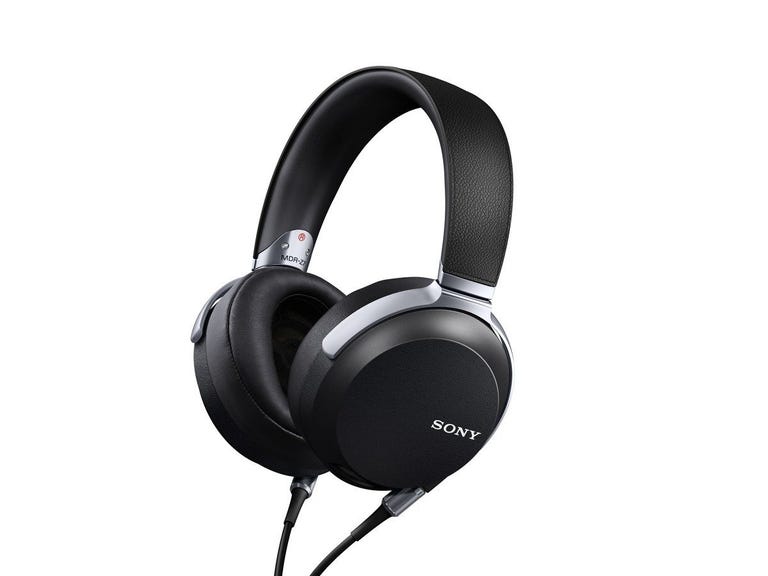 Why You Can Trust CNET
Why You Can Trust CNET Sony MDR Z7 review: A high-end Sony headphone that's truly high-end
Finally, Sony's made a headphone that can go toe to toe with the top audiophile models.
Sony offers a huge range of headphone models, but it hasn't made a headphone that goes toe to toe with the top audiophile models in quite some time. The MDR-Z7 is such a headphone. It looks, feels and sounds like the real deal -- and it better, considering it costs $700 (£550, AU$1000), though it can be found for less online.
The Good
The Bad
The Bottom Line
At this price point, a lot of audiophiles choose to go with an open-back headphone to get that more open, airy quality that open-back headphones deliver (the Beyerdynamic T90 , HiFiMan HE-400i or various Grados, for example). The MDR-Z7 is a closed-back design but manages to sound more like an open-back, so imaging is broad and beautifully focused.
The benefit of that closed-back design is that the MDR-Z7 doesn't leak much sound and its plush "pressure-relieving urethane cushions" with 3D-sewn covers do a good job passively sealing out ambient noise. This is a really comfortable headphone and while not as light as the MDR-1A , it's relatively light (335 g or 11.8 oz. without cable) for a full-size high-end headphone that has a sturdy metal headband and hinges.
It's also worth noting that the MDR-Z7 has been designed to be a quiet headphone so as not to take away from the listening experience: "Precise component machining, with the added placement of silicon rings around every moving axis, realizes smooth and silent earcup movement," Sony says.
You get two detachable oxygen-free copper cables: a 3-meter (9.8-foot) conventional stereo cable and a shorter 2m (6.5-foot) double-headed balanced audio cable that splits the channels and is designed to work with balanced audio headphone amplifiers like Sony's $1,000 PHA-3. You can use the headphones with a mobile device, but that 3m cable is a little long for on-the-go-use.
If you want to try to eke out even better sound out of the headphones, Sony also sells braided cable upgrades (courtesy of Kimber Kable) that are designed for home, on the go and balanced amplifier use.
A gold-plated 1/8-inch (minijack) to 1/4-inch (phono) plug adapter is included, but no headphone case or protective carrying pouch ships with the headphones.
Performance
We tend to jury test a lot of the headphones we review, and I had editor Ty Pendlebury and CNET contributor Steve Guttenberg try these headphones (Steve reviewed them for another publication, so he was already familiar with them). We all agreed they're bona fide audiophile headphones.
As we said, imaging is broad and beautifully focused. That really describes the MDR-Z7's overall sound, which is very linear and transparent. You hear more of the recording -- good or bad -- which is exactly what audiophiles want -- you get the feeling that the headphone, which has 70mm drivers, isn't adding or taking anything from the sound of your music.
Harsh recordings will sound harsher than you've heard them before, but the best ones will sound better than ever. That's usually the case with these types of transparent headphones, but there's enough bass here to appease folks who crave lots of bass. That said, it's not overemphasized the way it is with a lot of today's headphones.
We compared the MDR-Z7 with Bowers & Wilkins' top-of-the-line P7 (which you can buy for about half the price of the Sony). They're very different-sounding. The first thing we noted was perspective. The P7 makes instruments sound closer, while the MDR-Z7 gives them some distance, making the sound feel less stuck inside your head. There's an immediacy to the P7's sound we like, but in the end we preferred the MDR-Z7's bigger soundstage, which seemed more natural.
Bass definition and impact exceeded the P7's and the MDR-Z7 is also more comfortable to wear for extended periods of time.
This headphone will sound terrific plugged into your phone, but to really hear it at its best you need a high-end headphone amplifier, something along the lines of a $249 Schiit Audio Asgard 2 or Sony's $999 portable PHA-3 digital converter/headphone amp.
With a great amp, the MDR-Z7's dynamic punch improves, treble is more delicate and bass plumbs deeper. If you're going to invest in a high-end headphone like the MDR-Z7, it makes sense to hear what it can do.
We also tried the headphone with the $400 PonoPlayer , which has a balanced audio option (it has two outputs to plug into), and came away wondering why Pono didn't market the player to be used in this mode with a headphone like the MDR-Z7. The player sounds significantly better when used in balanced audio mode -- it plays louder, the bass is stronger and overall definition is improved.
Conclusion
There are a lot of really good headphones that cost less than the MDR-Z7. For example, we like the NAD Viso HP50 , the Audio-Technica ATH-MSR7 and Sony's own MDR-1A . From a build quality and comfort standpoint, the the MDR-Z7 has those models beat (the MDR-1A is also very comfortable). From a sound standpoint, it isn't going to blow those less expensive headphones out of the water, but, depending on your source material and hardware (device), you'll get even more impressive sound from the MDR-Z7 and it plays well with other high-end components, such as headphone amplifiers that offer a balanced audio option.
In short, as far as audiophile headphones go, the MDR-Z7 is the real deal.


